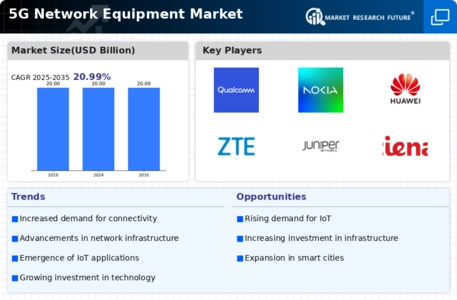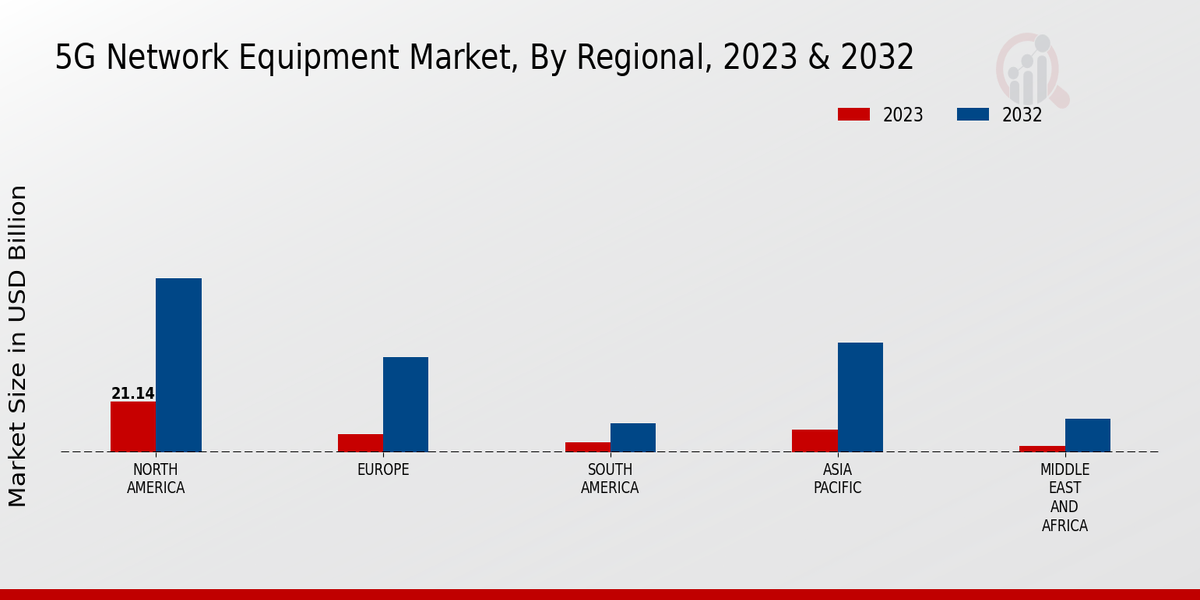Emergence of Smart Cities
The emergence of smart cities significantly impacts the Global 5G Network Equipment Market Industry. Urban areas are increasingly integrating advanced technologies to improve infrastructure, enhance public services, and promote sustainability. 5G networks are essential for enabling the connectivity required for smart city applications, such as traffic management, public safety, and environmental monitoring. As cities worldwide invest in these technologies, the demand for 5G network equipment is expected to rise correspondingly. This trend suggests a robust market landscape, with the potential for sustained growth as urbanization continues to accelerate and smart city initiatives gain traction.
Market Growth Projections
The Global 5G Network Equipment Market Industry is characterized by stable growth projections, with a forecasted market value of 20.0 USD Billion in 2024 and maintaining this level through 2035. The compound annual growth rate (CAGR) for the period from 2025 to 2035 is anticipated to be 0.0%, indicating a plateau in market expansion. This stability may reflect a maturation of the technology and market saturation as 5G networks become ubiquitous. The industry stakeholders must adapt to this environment by focusing on innovation and efficiency to sustain their competitive edge in a potentially stagnant market.
Expansion of IoT Applications
The Global 5G Network Equipment Market Industry is significantly influenced by the expansion of Internet of Things (IoT) applications. As industries increasingly adopt IoT technologies, the demand for reliable and high-speed network infrastructure intensifies. Sectors such as healthcare, manufacturing, and smart cities are leveraging 5G capabilities to enhance operational efficiency and improve service delivery. The anticipated growth in IoT deployments is expected to contribute to the market's value, with projections indicating a steady state of 20.0 USD Billion by 2035. This trend underscores the necessity for advanced 5G network equipment to support the burgeoning ecosystem of connected devices.
Government Initiatives and Investments
Government initiatives and investments play a crucial role in shaping the Global 5G Network Equipment Market Industry. Various countries are implementing policies to accelerate the rollout of 5G networks, recognizing the technology's potential to drive economic growth and innovation. For instance, national broadband plans often include substantial funding for 5G infrastructure development. These initiatives not only facilitate the deployment of network equipment but also stimulate competition among service providers. As a result, the market is poised for growth, with a projected value of 20.0 USD Billion in 2024, reflecting the impact of supportive governmental frameworks on 5G adoption.
Rising Demand for High-Speed Connectivity
The Global 5G Network Equipment Market Industry experiences a surge in demand for high-speed connectivity, driven by the increasing reliance on digital services across various sectors. As businesses and consumers seek faster internet speeds, the need for robust 5G infrastructure becomes paramount. In 2024, the market is projected to reach 20.0 USD Billion, reflecting the urgency for enhanced connectivity solutions. This demand is further fueled by the proliferation of IoT devices, which require seamless and rapid data transmission. Consequently, telecommunications companies are investing heavily in 5G network equipment to meet these evolving consumer expectations.
Technological Advancements in Network Equipment
Technological advancements in network equipment are pivotal to the evolution of the Global 5G Network Equipment Market Industry. Innovations such as advanced antennas, beamforming technologies, and network slicing are enhancing the performance and efficiency of 5G networks. These developments enable service providers to offer improved connectivity solutions that cater to diverse user needs. As the market matures, the integration of cutting-edge technologies is likely to drive competition among manufacturers, fostering an environment of continuous improvement. This dynamic landscape may contribute to a stable market value of 20.0 USD Billion by 2035, as companies strive to remain at the forefront of 5G technology.























